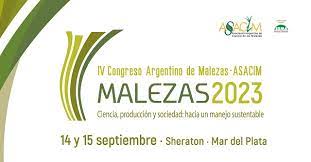Ver ítem
- xmlui.general.dspace_homeCentros Regionales y EEAsCentro Regional CórdobaEEA ManfrediPresentaciones a congresosxmlui.ArtifactBrowser.ItemViewer.trail
- Inicio
- Centros Regionales y EEAs
- Centro Regional Córdoba
- EEA Manfredi
- Presentaciones a congresos
- Ver ítem
Efecto de la presencia de rastrojo de maíz en la concentración de Piroxasulfone y S-Metolacloro en el suelo y en su control residual
Resumen
En Argentina, los herbicidas S-metolacloro y piroxasulfone se usan para el control de Amaranthus spp y de gramíneas resistentes a glifosato y/o graminicidas. Estos herbicidas no iónicos se adsorben al rastrojo, reduciendo su eficacia. El objetivo de este trabajo fue estudiar la presencia de rastrojo de maíz y el período entre aplicación y la primer lluvia, como reguladores de su concentración en el suelo y residualidad. Se realizó un ensayo en macetas,
[ver mas...]
En Argentina, los herbicidas S-metolacloro y piroxasulfone se usan para el control de Amaranthus spp y de gramíneas resistentes a glifosato y/o graminicidas. Estos herbicidas no iónicos se adsorben al rastrojo, reduciendo su eficacia. El objetivo de este trabajo fue estudiar la presencia de rastrojo de maíz y el período entre aplicación y la primer lluvia, como reguladores de su concentración en el suelo y residualidad. Se realizó un ensayo en macetas, usando suelo franco limoso y 3,06 % de materia orgánica, bajo invernáculo con diseño completamente aleatorizado en arreglo factorial de los tratamientos y cuatro repeticiones. Los factores fueron: 1. Rastrojo: con rastrojo de maíz (10.000 kg MS ha-1) y sin rastrojo; 2. Herbicida: Piroxasulfone (170 g i.a. ha-1), S-metolacloro (1248 g i.a. ha-1) y sin herbicida; 3. Riego: 1, 8 y 14 días después de la aplicación (DDA). Se realizó un riego de 20 mm en cada maceta y 72 h después del mismo se retiró el rastrojo. La concentración herbicida, se determinó en los 2 cm superiores de suelo a los 3 y 17 días desde el riego (DDR) por HPLC. El control residual se determinó contando número de plantas emergidas de Eleusine indica, sembradas en cada maceta. Los resultados mostraron que la presencia de rastrojo afectó fuertemente la concentración de ambos herbicidas en el suelo con riego 1 DDA, dado que se redujeron en 86,4 % y 84,6 % las concentraciones de S-metolacloro y piroxasulfone a los 3 DDR, respectivamente. Por último, con riego 8 y 14 DDA se registraron diferencias en las respuestas de los herbicidas. Mientras S-metolacloro se redujo significativamente respecto del riego a 1 DDA; piroxasulfone no mostró diferencia en los tres momentos 1, 8, 14 DDA. El control residual de ambos herbicidas estuvo directamente relacionado a su concentración en el suelo.
[Cerrar]
In Argentina, the herbicides S-metolachlor and pyroxasulfone are used to control Amaranthus spp and grasses resistant to glyphosate and/or graminicides. These non-ionic herbicides adsorb to the stubble, reducing their effectiveness. The objective of this work was to study the presence of maize stubble and the period between application and the first rain, as regulators of its concentration in the soil and residuality. A trial was carried out in pots,
[ver mas...]
In Argentina, the herbicides S-metolachlor and pyroxasulfone are used to control Amaranthus spp and grasses resistant to glyphosate and/or graminicides. These non-ionic herbicides adsorb to the stubble, reducing their effectiveness. The objective of this work was to study the presence of maize stubble and the period between application and the first rain, as regulators of its concentration in the soil and residuality. A trial was carried out in pots, using silt loam soil and 3.06 % organic matter, under a greenhouse with a completely
randomized design in factorial arrangement of the treatments and four replications. The factors were: 1. Stubble: with maize stubble (10,000 kg DM ha-1) and without stubble; 2. Herbicide: Pyroxasulfone (170 g a.i. ha-1), S-metolachlor (1248 g a.i. ha-1) and without
herbicide; 3. Irrigation: 1, 8 and 14 days after application (DAA). A 20 mm irrigation was carried out in each pot and 72 h after it, the stubble was removed. The herbicide concentration was determined in the upper 2 cm of soil at 3 and 17 days from irrigation (DFI)
by HPLC. The residual control was determined by counting the number of Eleusine indica emerged plants planted in each pot. The results showed that the presence of stubble strongly affected the concentration of both herbicides in the soil with irrigation 1 DAA, since the concentrations of S-metolachlor and pyroxasulfone were reduced by 86.4 % and 84.6 % respectively, at 3 DFI,. Finally, with irrigation 8 and 14 DAA, differences were registered between the herbicides. While S-metolacloro was significantly reduced with respect to irrigation at 1 DAA; piroxasulfone did not show a difference in the three moments 1, 8, 14 DAA. The residual control of both herbicides was directly related to their concentration in the soil.
[Cerrar]

Autor
Ustarroz, Diego;
Bedmar, Francisco;
Rampoldi, Edgar Ariel;
Hang, Susana;
Descripción
Presentación en diapositivas y resumen
Fuente
IV Congreso Argentino de Malezas “Ciencia, producción y sociedad: hacia un manejo sustentable”, 14 y 15 de septiembre de 2023.
Fecha
2023-09-14
Editorial
Asociación Argentina de Ciencia de las Malezas (ASACIM)
Formato
pdf
Tipo de documento
documento de conferencia
Palabras Claves
Derechos de acceso
Abierto
 Excepto donde se diga explicitamente, este item se publica bajo la siguiente descripción: Creative Commons Attribution-NonCommercial-ShareAlike 2.5 Unported (CC BY-NC-SA 2.5)
Excepto donde se diga explicitamente, este item se publica bajo la siguiente descripción: Creative Commons Attribution-NonCommercial-ShareAlike 2.5 Unported (CC BY-NC-SA 2.5)


